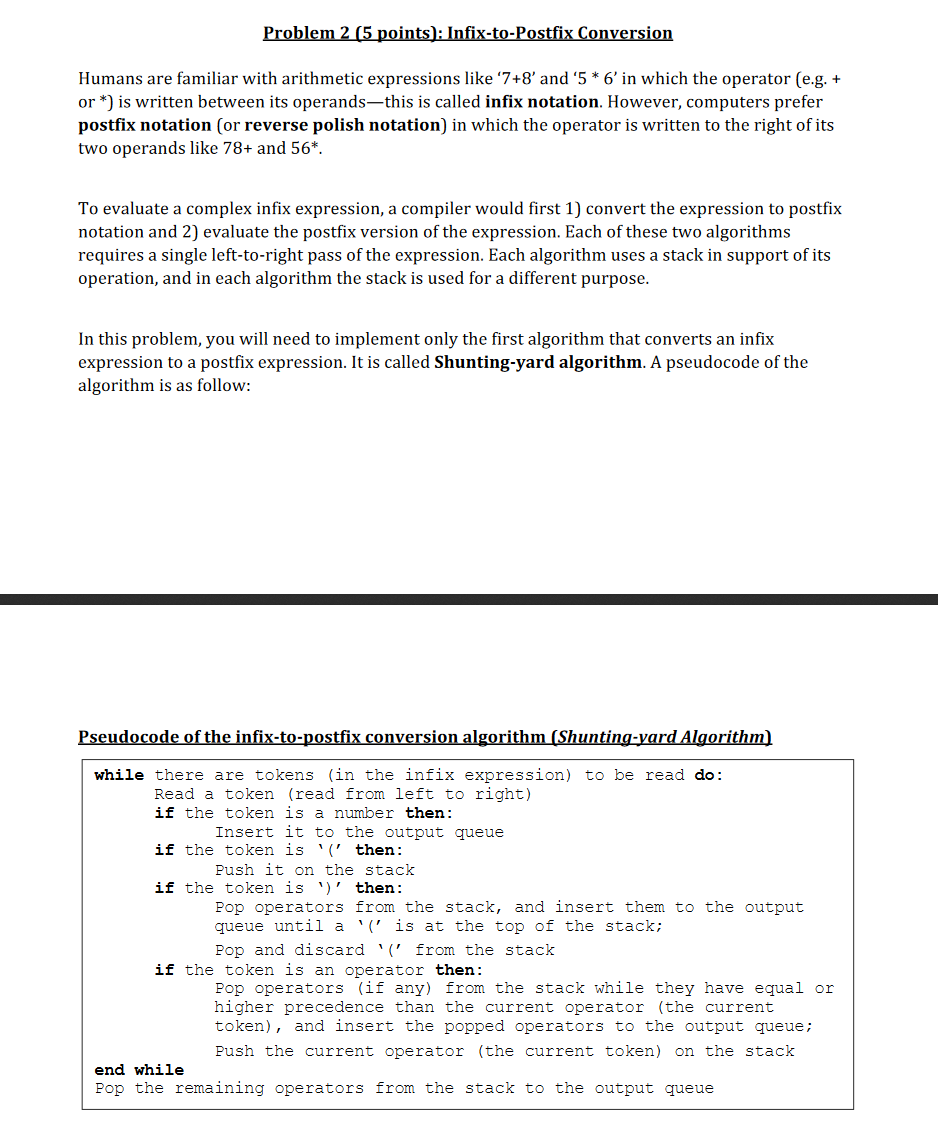Infix To Postfix Shunting Yard
infix postfix shuntingConvert regular expression from infix to postfix notation using Shunting-yard algorithm. In computer science the shunting-yard algorithm is a method for parsing mathematical expressions specified in infix notation.
Insert this string to stack.

Infix to postfix shunting yard. The algorithm was named shunting yard because its activity resembles a railroad shunting yard. That means this algorithm is used to convert the infix notation to RPN. Edsger Dijkstra developed this algorithm.
Converting infix to postfix. It can produce either a postfix notation string also known as Reverse Polish notation or an abstract syntax tree. The final string in the stack is the infix expression.
Infix to postfix notation in Haskell Shunting-yard algorithm 4. InfixNotation - this simply holds a few public variables and calls the public methods on the below two classes. The postfix notation is also known as the reverse polish notation RPN.
Example Convert abcde to Infix. A similar algorithm produces a prefix expression known as Polish notation. This is done because it is hard to tell a program to compute the infix.
And the source code. Negative means right-associative otherwise left. Here is the psedocode of the algorithm.
Insert a as explicit concatenation operator. The postfix notation is also known as the reverse polish notation RPN. It produces the postfix notation.
Dijkstra first described the Shunting Yard Algorithm in the Mathematisch Centrum report MR 3461. The algorithm was invented by Edsger Dijkstra and named the shunting yard algorithm because its operation resembles that of a railroad shunting yard. In2post 2 2 2 2 in2post 1 2 3 1 2 3 in2post 5 - 4 31005 12-6 12 -8 5 4 - 3 1005 12 6 12 8 - - in2post 2 45 2 45 ERROR.
A simplified version of the Shunting-yard algorithm complete version For all the input tokens S1. ShuntingYardAlgorithm - this converts an equation in infix notation into postfix notation aka RPN. The algorithm was named a Shunting yard because its activity is similar to a railroad shunting yard.
Description In computer science the shunting-yard algorithm is a method for parsing an infix mathematical expression to either a postfix notation expression also known as Reverse Polish notation or an abstract syntax tree. If token is an operator x. Stack Exchange network consists of 176 QA communities including Stack Overflow the largest.
Repeat step 2 until are characters are read. The shunting yard algorithm was invented by Edsger Dijkstra to convert an infix expression to postfix. Example of how it works.
23 Dec 2013 The Shunting Yard algorithm was developed by the great Edsger Dijkstra as a means to parse an infix mathematical expression into Reverse Polish notation postfix. Ive written an infix to postfix converter in Haskell using the Shunting-yard algorithm. 4 18 9 3 -.
4 1 8 9 3. PostfixNotation - this evaluates the equation in postfix notation and returns a numerical result value. The Shunting Yard algorithm was developed by Edsger Dijkstra as a means to parse an infix mathematical expression into Reverse Polish notation postfix.
Read the next token. We have not seen it yet given the above infix notation that the shunting yard algorithm will output the reverse polish notation as. The shunting yard algorithm is mainly used for parsing mathematical expressions specified in infix notation.
First let talk about the Shunting yard algorithm The algorithm converts an infix expression to a postfix expression. Many calculators use this algorithm to convert the expression being entered to postfix form. But in this case the stack is used to hold operators rather than numbers.
4 18 9 3. It uses a stack. Here is an step-by-step image for ABC-D from wiki.
Now we know that the answer to this from the rule or order of operations is 7 7 7. The Shunting Yard Algorithm Edsger Dijkstra developed his Shunting Yard algorithm to convert an infix expression into a postfix expression. Consider the following infix notations.
It is a stack-based algorithm. I need to modify my algorithm to return a prefix polish expression and I dont know how. Insert at the beginning and end of the string.
I ended up using the Shunting-Yard Algorithm to convert from infix notation to RPN as the. 4 1 8 9 3. I have successfully implemented the shunting-yard algorithm in C to convert an infix expression to a postfix expression RPN.
17 Nov 2020 The shunting yard algorithm is used to convert the infix notation to reverse polish notation. 4 18 9 3. For all the input tokens.
3 4 2 1 - 5 2 3 postfix. Using said notation allows the computer to evaluate the expression in a simple stack based form examples of which I have shown in Scala. Shunting Yard Algorithm AlgorithmsParsersJava The shunting yard algorithm is used to parse input in infix notation while respecting the order of operations.
